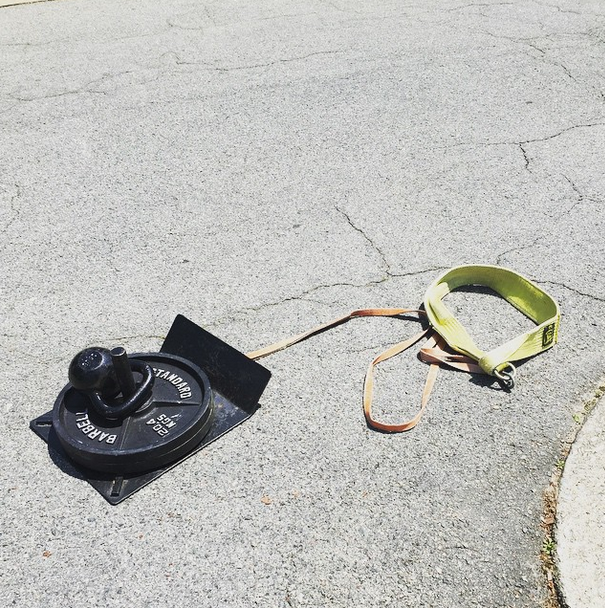
In my younger days, and even still now, I heard that no one should tow a sled (walk or run) with more than 10 percent of his body weight, as it will alter technique and, in turn, slow one down rather than make him faster. I also learned that squatting is what makes someone faster. Make someone stronger and he becomes faster (to a point). The squat was the king of the exercises and everyone should do them. That’s all you need to do with your athletes to succeed.
Well, I've found that this and many other things I’ve learned in my career were wrong. Much of this article is based off a research poster that I presented at the 2014 ACSM Central States Chapter meeting. At this meeting, I showed the results of a former quarterback from 2005 who had multiple disc issues and couldn't tolerate direct axial loading. Sometimes indirect loading was intolerable as well, mostly dependent on if/how bad his flare up was at the time. By intolerable, I don’t mean that he didn’t want to do it. I mean that it would cause such excruciating pain for days that it wasn't worth it.
Without the ability to do squats, which was the only exercise you needed or so I’d been told since the mid-1990s, we thought that his days of seeing improvements in speed and power were done. I had some...well, a significant amount...of experience in Westside and their special exercises. I remembered doing sled towing for max effort or for a deload week. I decided that because I had nothing to lose, this was the perfect time to gamble. I would make his sled towing his squat. This is what we would progress and pride ourselves on. This is what we would make the bulk of our lower body workouts and spend hours busting our asses (well, really his ass) on.
For the off-season program, which only lasted about six weeks due to spring ball, we focused our efforts here instead of on squatting for the lower body. During the post-testing phase, we found that our efforts paid off—he was able to run and jump better than ever. He had beat his previous 40-meter personal record by 0.27 seconds, and he beat his previous vertical jump record by two inches. Not bad for a guy who was previously thought to not see gains ever again, right? He only had his all-time best performance when no one was expecting him to even be able to perform. Here is what we did...
In the first week and on day one, we started pulling for eight trips down and back for thirty yards (about ninety feet). On day two, we pulled for shorter trips (sixty yards) and did six trips down and back (for 12 reps). We went up in weight when we could but primarily based everything off of an RPE. How hard was that? On the lighter days with greater distance, we kept more to a seven, and on the heavier, shorter days, we went to an eight or nine. His perceived effort is what we used. We started at two plates and added on either a 45-pound plate or 25-pound plate to increase the weight. We added more and more weight to the bar. He got stronger and stronger, and as a result of that, he got much faster. By the end of the training cycle, he was towing 600 pounds with a 200-pound person sitting on top of the plates.
But wait a second. What about the 10 percent thing? Shouldn’t that have made him slower by altering his running technique? This is an old and fast rule and because I had heard it so many times when I was younger, it had to be true, right? Wrong!
Research by many out of Australia recently have shown through several experiments that sled pulling is in fact an amazing way to actually transfer over to running speed. It is thought that it increases the horizontal strength component. Kawamori and colleagues (1) performed a study using light load sleds and heavy load sleds. The performance measure was a 10-meter sprint, of which they took a 5-meter split as well as a 10-meter split. They did pre-post testing and had eight weeks of training. At the post-test, both groups did improve their sprint time on the 10 meter. The light group did so at about a 3 percent improvement rate while the heavy sled group saw a 5 percent improvement rate. Also, interestingly enough, at the 5-meter split, the heavy sled group again saw a 5 percent improvement, but the light sled group saw no improvement at all for that split.
Another study by Martinez and colleagues (2) utilized 10 percent and 20 percent of body weight on weighted sleds. Again, the heavier weight ruled supreme. The heavy sled group noted greater horizontal ground reactive forces as well as horizontal impulse forces as a result of their training. The lighter sled group didn't see improvements in either of these horizontal force measures. By being able to produce a greater amount of force horizontally, the individuals were able to improve their speed. Several publications by Kawamori and colleagues (1, 3) show that the benefits of increasing horizontal force output far outweighs the alteration of running form. One important thing to note though is that if the athlete is instructed not to run nor are they allowed to run, running form most likely won't be compromised.
Now, 0.27 seconds is a big improvement, and I'm not sure if that would be seen on a consistent basis. He increased his absolute strength greatly on this exercise in such a short time. Occasionally, there are outlier “high responders” to exercise and he certainly may have been one for this type of exercise. However, implementing sled drags will likely have a one-time major jump in the sprinting performance for the athlete, meaning that he will have one huge improvement. They say a chain is only as strong as its weakest link. When that weakest link is made as strong as the chain, the chain holds the load that it was meant to. After the initial improvement, it is likely that the sprint performance, while still improving, will slow down.
It should be noted that there are two force components for sprinting and other team-based activities: vertical force component and horizontal force component. In a "published ahead of print" article, Dobbs and colleagues showed that it is important to evaluate the horizontal component because it is all too often underutilized (4). West and colleagues showed in two studies that the utilization of heavy sled resistance training improved speed and again referred to the horizontal force component as a reason for the improvement (5, 6). It is easy to develop the vertical force component through squatting, deadlifting and many other exercises in the weight room. The horizontal force component is often overlooked as it is developed through less traditional means.
Sled pulling could still easily be added in to any team's workout regimen. Just find a place and add it in. If the facility is one that has an area for warm ups like a turf facility or somewhere far away from the training floor, simply do it there and then. Otherwise, do it after your main exercise. For example, do heavy squats and then the more moderate sled pulls or moderate squats and heavy sled pulls or heavy and heavy or moderate and moderate. A major benefit to utilizing sled pulls is the minimal eccentric, which reduces the risk of muscle soreness and thereby increases the ability to do it more often or more intensely. (Admittedly, eccentrics are a major factor in training for sport, so eccentrics should be introduced elsewhere if this is the main exercise.) In my humble opinion, it only matters that you get it in, not when you get it in. You could argue that doing it at the start of the workout when the athlete is fresh and trying to put out effort will have the greatest increase and translate to the greatest sprint performance. You could also argue that doing it at the end of the workout will still allow the athlete to produce force in a horizontal component after exhausting the muscles responsible for the vertical component (some of which are the same muscles).
In the end, I want to make three points:
- I'm not saying that squatting is inferior to sled pulling, nor am I saying don't squat. I'm saying that there is more to sprinting than meets the eye because there are horizontal and vertical components. You have to train both.
- All the research that has been done on heavy sled pulling used non-track athletes. The 10 percent rule may or may not hold true for them. Currently, I can’t say because I haven’t seen any research on this nor have I done this with any track athletes. Also, what I had done was done walking when towing the sled. At no point was the athlete allowed to run. If he tried to run, he had to start over. For football players and other team sports, sprinting and sprint mechanics is GPP. For track athletes, it’s SPP. Yes, it is true that those athletes sprint, but they often sprint when having to dodge, accelerate and decelerate and often have to do so with the use of a sporting implement.
- Just because you were told something doesn’t make it true. Changes and improvements never came by not questioning and simply accepting everything you’re taught as truth. Read, research, experiment and take risks. Increase your knowledge base and you will make mistakes, but you will make findings as well. Seek to understand why something worked or why it didn’t work. While it takes time and effort, not only will your athletes become strong(er) of body, but you will become strong(er) of mind.
References
- Kawamori N, Newton R, Nosaka K (2014) Effects of weighted sled towing on ground reaction force during the acceleration phase of sprint running. J Sports Sci 32(12):1139–45.
- Martinez-Valencia MA, et al (2014) Interrelationships between different loads in resisted sprints, half-squat 1 RM and kinematic variables in trained athletes. Eur J Sport Sci 14(S1):S18–24.
- Kawamori N, et al (2013) Effects of weighted sled towing with heavy versus light load on sprint acceleration ability. J Strength Cond Res.
- Dobbs CW, et al (2014) Relationship between vertical and horizontal jump variables and muscular performance in athletes. J Strength Cond Res.
- West DJ, et al (2013) Effects of resisted sprint training on acceleration in professional rugby union players. J Strength Cond Res 27(4):1014–8.
- West DJ, et al (2014) The metabolic, hormonal, biochemical, and neuromuscular function responses to a backward sled drag training session. J Strength Cond Res 28(1):265–72.
Photos courtesy of @power_tri_training











Enjoyed you on the Pacey Podcast by the way. Let me know when you come to the states for a conference, hopefully we can cross paths.
Cory
Thanks for the great article.
Typically what was the weight difference between the light day (longer distance) and the heavier day (shorter difference) or was that too based of RPE?
Thanks
Euan
Great question- that would have been a good thing for me to include up there, right? Whatever they did on the heavy day, I just did 60% of that weight for the lighter day. I think using RPE would have been good on that too, but I just never thought about it. I have read before about the empirical rule of 60 where your lighter day should be about 60% of your heavier day and went with that.
Bryan
Where are you located now and your phone information. trying to get in touch with you Coach McCormick Head Strength coach Huston Tillotson University in Austin TX